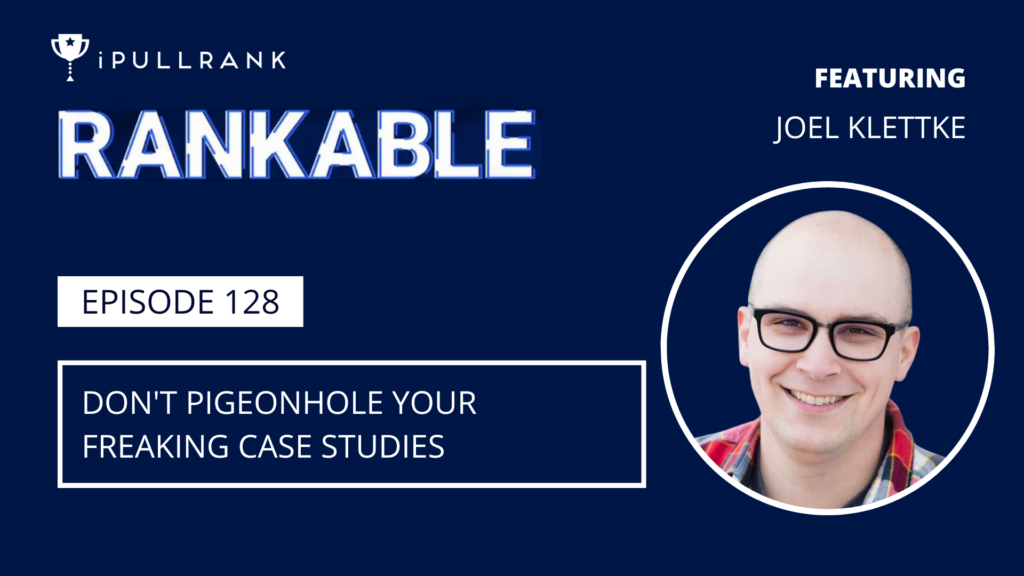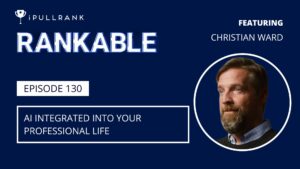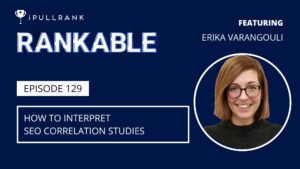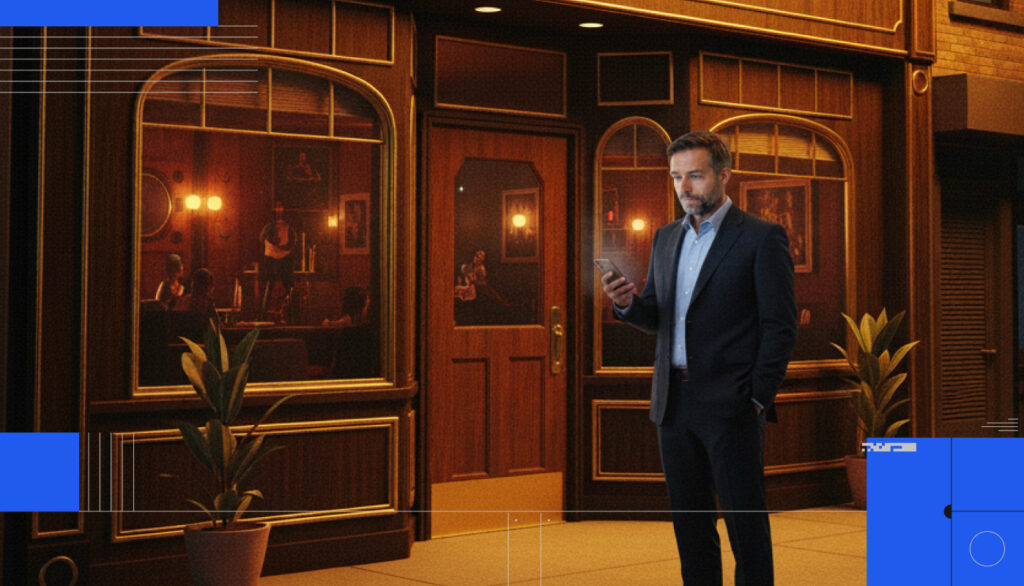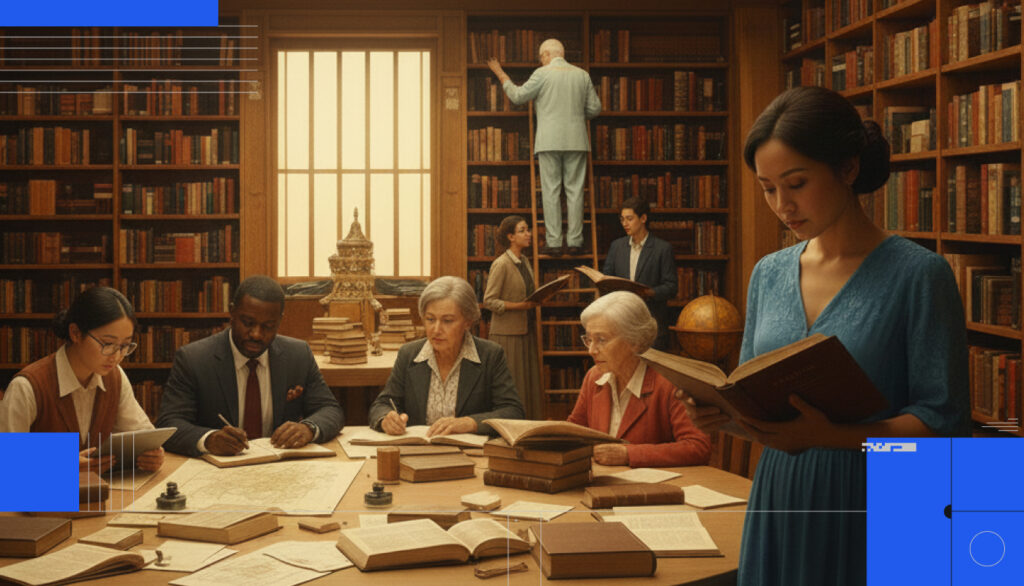The Rankable Podcast
Don't Pigeonhole Your Freaking Case Studies
Featuring Joel Klettke
Episode Time Stamps
[0:00] Intro
[2:57] How can B2B companies effectively integrate SEO strategies into their customer success stories to enhance their online visibility?
[5:17] From an SEO and human perspective should you try to use jargon in the content of the customer story?
[7:35] Don’t limit the use cases and potential of your case studies.
[10:50] Leveraging case study videos for SEO value.
[12:45] Are SEOs involved in case study creation? Should they be?
[15:10] Who should own case study creation?
- [17:45] Does the case study deliverable go according to plan? What’s the output?
- [23:25] Rapid Fire Rankings
In episode 128, Joel Klettke of Case Study Buddy drops by to discuss the underrated value of the case study for SEO and beyond.
Joel argues that a well-designed customer story is not a fluff piece. How do your buyers talk? Should you use jargon in your customer stories? Klettke shares his experience of creating a buffet of content from your customer story interviews.
We also discuss how to leverage video for your customer stories and who he would want to create a case study for. Listen for the customer story insights, but stay for his generative AI hot take.
Listen on your favorite platform
This Week's guests
Joel Klettke
Title: Founder / President
Company: Case Study Buddy Inc.
Bio:
Website: Case Study Buddy Inc.

Rank your best SEO marketing win:
Rank your top 3 SEO tools:
- Ahrefs
- Semrush
- ScreamingFrog
Rank your best SEO or trick or tactic:
What’s the biggest scam in SEO that you’ve recently seen?
I don’t know that it’s necessarily a scam, but there was all the controversy around that brand generating a huge amount of AI content and ‘stealing’ market share from competitors.
I viewed it as an interesting experiment (even if the sharing of it was a little shortsighted/arrogant), but it generated some REALLY strong opinions from the SEO community around how this was so evil/broken/terrible.
I had to laugh — yes, the generating content part might be questionable with the tech, but SEOs have been ripping off each others’ strategies for YEARS, so I’m not sure what made this so special other than the cockiness in the way it was shared.
Rank what you love most about the SEO industry:
Probably what I also hated most about it when it was my job: it is always changing.
Rank your top 1-3 marketers:
- Andy Crestodina
- John-Henry Scherck
- Joanna Wiebe
- Stefan Georgian
What’s your Generative AI hottake?
My hot take on this is that generative AI can, in fact, generate creative content.
There’s this weird notion that since it was trained on other content, generative AI is unable to come up with original ideas. That’s only somewhat true because we’re missing half the equation: the human using it.
I’ve seen, firsthand, how introducing creative prompts can drive wild, new ideas out of generative AI, especially when it comes to imagery. Yes, it’s anchored in the past, but it can iterate toward the future.
Transcript:
Garrett Sussman:
Welcome back to another episode of the Rankable podcast. I’m your host, Garrett Sussman of iPullRank, and we are back for another season. It’s 2024, the year of AI is in the books, and yet we’re probably just getting started. But today, I am hyped. Someone who’s been playing around with it but, you know, his other side of his job, his other focus, is really in the authentic humanity of marketing and business, talking to customers.
I am joined today by Joel Klettke. Joel is the founder and president of Case Study Buddy. Now, that’s a specialized team. They work with B2B brands like HubSpot, Loom, scaling their customer stories, and driving more ROI from each one. He’s a sought-after conversion copywriter.
He happens to be, as you can see if you’re watching the video, a bald Canadian and a tired dad, trying to figure it all out. Like, at the time of this recording, actually, he has a two-month-old, uh, along with his two other kids in the house.
Thank you so much for joining me today, Joel. How are you doing, man?
Joel Klettke:
I’m good. I’m tired. Um, three kids and now two driveways to shovel because I got wrangled into taking care of my next-door neighbor’s. And it’s like, you know, I know most people don’t speak Celsius, but it’s like minus 27 today. So, it’s good and cold. There’s a lot of snow on the ground. I tried to have a social life yesterday, so I went to a Flames game. You know, that was not a mistake, but I’m paying for it now. So, I’m good. I’m tired, but I’m good.
Garrett Sussman:
I was going to say, like, grass is greener – in this case, the snow is whiter. I mean, you probably are sick of it up in Canada, and yet here I am outside of D.C. They promised us some snow, and you know, climate change and all that jazz, everything’s more temperate. We just got some freezing rain, and my little one is like, “Dad, where’s the snow?” and I’m like, “I’m so sorry, it’s not coming.”
Joel Klettke:
Yeah, yeah. I mean, we had such a temperate leadup to this; we got kind of used to it. And now, it’s come back with a vengeance. So thankfully, we’re Canadian; we’ve dealt with this before. You know, it’s no panic, but yeah, snow shovels are getting good use.
Garrett Sussman:
Well, I’m excited to talk about this kind of intersect between case studies, customer stories, testimonials, and SEO, because I think it’s very overlooked in the SEO industry.
I think, for the most part, a lot of people consider customer stories as purely sales collateral, purely helping the business, and don’t play a role in the buyer journey that people will never actually find it. And I’m excited for you to kind of disprove that perspective. To kind of start us off, can you talk a little bit about how B2B companies can effectively integrate SEO strategies into their customer success stories to enhance their online visibility?
Joel Klettke:
Yeah, I think start from the perspective of what these stories are really about. They’re about the questions that someone was asking, the solutions that they found, the journey through that solution, and ultimately, to a result they were looking for. And inherent in all of that are all kinds of queries, long-tail and otherwise, that someone might search, that this type of content can help inform. You know, if you’re speaking about a particular industry, and someone’s looking for someone who’s earned results in that space, there may be long-tail queries around that.
If you’re speaking to, you know, like even for your own brand’s SEO, protecting your positioning for things like queries around reviews, or around case studies, or around pricing, or these types of things, you have the chance to maybe creatively address some of those queries by strategically embedding those in the stories you tell.
There are many ways to tell a customer success story. Some of those can be the long-form narrative pieces, you know, lots of meat there for a search engine to chew on. Other times, we have clients who publish both that type of story, sort of angling towards some queries or some intent, and then they’ll go ahead and publish something from the same transcript that’s more of a Q&A style blog post, where the question is actually right in the piece. You’re working to make sure that those are different enough to not kind of cannibalize each other.
But I think the realization that these are not just fluff pieces, these are not just lists of bullet points and nice quotes, that done well, you can be really intentional about what you target in a story, what questions you address in a story, and then use that to get that story to rank and show up for some of these long-tail queries. And now instead of being immersed in a sales pitch when someone clicks through, they’re immersed in something that feels very organic and natural, which is a conversation that a real client of yours is having.
The nature of these things, you know, people don’t realize it, but it lends itself really nicely to some of these SEO strategies that companies deploy.
Garrett Sussman:
It’s really interesting, being able to extract the most interesting and useful information when you’re doing the interviews. Like, your team has kind of perfected that interview process. You’re, in essence, journalists. How do you feel about the jargon aspect of it? Do you try to avoid it, or do you, from like an SEO perspective, be like, “Okay, let’s get that jargon into the conversation because it might actually help us”?
Joel Klettke:
Much of this question comes down to how does your audience identify, right? There is some jargon that’s meaningless, and marketers are terrible for this, where it has no meaning even to them. But then there are spaces like engineering, data engineering, data analysts, developers, that kind of thing, where there’s actually a lot of meaning and identity wrapped up in that jargon. They use that language because to not use that language would be a slight against their credentials, their expertise. You wouldn’t belong in the space if you didn’t communicate in that way.
When you’re thinking about do we include this, do we not, I think what it comes down to is do your buyers actually talk that way? Is that the way that they communicate? Is that something they’ll look for?
A classic, not classic, but an example of this is when we’re writing a landing page for ourselves. We’re trying to make some inroads into AI solutions as potential clients. We love the space that’s emerging; we see a ton of potential. We’re also trying to make inroads into cybersecurity. We see a ton of potential there. When we’re writing a landing page for cybersecurity, for example, we need to have some abbreviations, like, you know, capture the attention of the CISO, and those types of things because when we can communicate that, their light bulb goes on, “Oh, they get it. They talk like us. They know our space. They can serve us well.”
Jargon is actually really important. It has a really great role to play when you’re speaking to or trying to communicate with an audience that holds it dear and uses it regularly. It’s a way of kind of putting up the flag and saying, “We get you. We get this space. We can serve it well.”
You want to cut it when it’s meaningless, when it’s your jargon and not your audience’s jargon. But otherwise, as long as your reader, your buyer, your decision-maker knows it, understands it, values it, it should stay.
Garrett Sussman:
Do you, when you’re having conversations with clients, does SEO come up ever, or is their perspective really all about the sales collateral aspect of it?
Joel Klettke:
People put case studies in a box, and it’s like a box that almost doesn’t belong anywhere. It really varies, right? Like, who’s usually tasked with doing case studies? Well, it’s the marketing team, product marketing, customer marketing. Who uses case studies? The sales team, the marketing team as well.
A lot of people, you know, the traditional viewpoint on these assets is well, it’s an end-of-journey asset. Someone’s on the finish line; you hand it to them, nudges them over the line. That’s a really limited way of thinking about it because whether it’s a written story or a video testimonial, for example, we haven’t even talked about doing SEO for video. Talk about low-hanging fruit.
If you can get your video testimonials ranking or if you can adapt that content to a how-to type of video, I mean, the world’s your oyster at this point. There’s still so much untapped potential there. A lot of people put case studies and customer stories, video testimonials, in this tiny little box where it’s like, well, this is something we do once in a while. No one really owns it. We’re just going to kind of host it on the site; that’s where it will live, or we’ll give it to the sales team, we’ll do whatever sales teams do with it when the reality is, these, you know, I’ve worked in marketing long enough to know.
I’ve done SEO. That was my job for almost 5 years agency side. I’ve done copywriting, ads, email, outreach. I’m now producing these things, and the reality is, done well, these stories fit across the entire spectrum of your sales and marketing activity.
From demand gen and advertisements, like we have clients who very successfully run ads and remarketing ads to their stories instead of landing pages, and it converts well for them.
Your old outreach, you know, bringing stories and proof into that, makes a big difference. Mining these interviews for positioning and your own copywriting, your own messaging, there are benefits there that trickle into everything else.
Nurturing and getting people on board, retention, even upselling and cross-selling, right? If you have a client who’s made a decision to go to a more premium tier, capture that story. Tell it to people considering moving to that premium tier, and you’re throwing gasoline on the fire. So, you know, if nothing else, I think one of the things we really try to work on is when someone comes in, they have this preconceived idea of where this thing fits and what it’s meant to do and how it should look.
We’re trying to expand that mindset and get people to see like, no, it’s not just write a 1500-word piece, post it to your blog, and move on with your life. It’s creating this whole buffet of different pieces of content that will work for you across the entire sales and marketing spectrum.
There’s a lot of education, I think, even now, that we’re still doing with even seasoned marketers because for so long, this has been second rate or, you know, second consideration, or just not really thought about.
Garrett Sussman:
No, I mean, it speaks and obviously, I’m coming at it saying like, sales collateral, sales collateral. And yet, obviously, it’s not just a checkbox. To your point, there’s a whole strategic approach to it. Can you speak a little to the video and the YouTube value, like you were leveraging case study videos for SEO value? Saying like, there are different ways that you can surface that. How do you approach it?
Joel Klettke:
For the SEOs listening, it comes down to number one, you want to look at what kinds of queries around questions your customers are asking. Comparisons, X versus Y. Like, what types of queries are already triggering video results? And then, how could we take a customer story and optimize it to fit there? Can we do that natively with just a testimonial and optimize in that way? Should we be putting together a reel that has lots of different perspectives? Are we taking those stories and embedding them again in more of a how-to, something prescriptive, something more like a playbook?
But there’s so much value because that visual real estate in search results is still substantial. I mean, yeah, the top is clogged up with ads and so on, but when you have map packs and all these things, they draw the eye.
Being able to surface a video in a landscape where otherwise it’s all just blue link, blue link, blue link, or ad, ad, ad, you can gain an outsized amount of attention. And you can communicate in a way that’s immediately compelling. I can watch, I can listen, I can engage versus I can click through, I can read, I can navigate.
It kind of changes the dynamic. It doesn’t have to be one or the other, but having that be part of your intentional strategy, you know, how are we labeling this? How are we promoting this? How are we structuring this to try to answer the question that someone might ask and trigger the video?
I think it’s a smart strategy that not nearly enough people are using. It’s interesting to me because now I’m thinking about some of the conversations that you’re having with clients on kickoffs, and I can imagine there’s a lot of business information gathering, obviously, that you have to do. How often are SEOs involved?
Garrett Sussman:
Are SEOs involved in case study creation? Should they be?
Joel Klettke:
In the conversation or does it typically get passed to them after the fact? Virtually never. I can’t recall the last time we ever had an SEO on the call. Like, SEO is for these stories, it is a remote consideration if it’s thought of at all. And really, again, because people don’t connect the dots. They put case studies in this bucket, this checkbox, like, get the customer story, okay. And it’s almost like just having these and having them live is the victory unto themselves. They don’t think about distribution. They don’t think about how someone is actually going to find this. They don’t think about the strategy for the storytelling. They don’t think about conversion and how we can actually get people to take action.
Something that drives me bonkers is you can go to billion-dollar brands’ websites. They have case studies with no calls to action. There’s no way to act on this very compelling, stealthy sales pitch you just gave me. I can’t do anything immediately other than go up to contact or whatever. What a whiff! You had the opportunity to make a very specific invitation to value, and you just didn’t do anything about it.
SEOs really aren’t top of mind. It’s not really part of the conversation. And I think there’s a reticence, too, right?Done well, the SEO part almost, it can inform at the beginning, and then it’s built after. It should be, in my mind, part of the strategy but not the strategy. I don’t think you should do case studies for SEO. I think you should bring an SEO perspective to your case studies, if that makes sense.
You don’t want SEO to be the primary reason you’re publishing these things, but that doesn’t mean it’s not a very compelling secondary or tertiary way of deriving value from them that again, it’s just not on the radar for people. I do think SEO should have a voice in where is their search volume based on what we’re seeing in sales, the questions we’re being asked?
How could we marry this up so that, okay, for every one person on a sales call asking this, the 500 people just Googling it can find something too. And to that point, like, if it’s not SEO, it almost makes it like we’re stepping outside the SEO box. I’m curious, outside of a generalist marketer…
Garrett Sussman:
Who should own case study creation? Who within a marketing department should own the case study? Is it a lifecycle thing? Is it a generation thing? Is it sales? What’s been your experience?
Joel Klettke:
It’s a rowboat is the best way of putting it. Marketing sits at the front, and they should be the ones kind of helping everyone move in unison because in isolation, if everyone’s rowing their own direction, you’re going to go in circles, right?
The trouble is, when marketing is just tasked with doing this and no one else is involved, well, sales doesn’t get what they need. Sales does not love, I can say definitively, 1500-word deep-dive pieces that marketers are enthralled with. They don’t necessarily love three-minute-long videos or five-minute-long videos for their scenario. They need something high-level, succinct, something really focused, something they can speak through.
When marketing doesn’t ever talk to sales about that, they don’t produce that. Sales is forced to use assets that aren’t really made for them but could have been.
I think the ideal is kind of that rowboat mentality, where it’s like, okay, you do need someone to drive and oversee and project manage, and that can be marketing. Within marketing, it depends on the size of the company, right? If there’s a product marketing function, it’s usually them. If there’s a customer marketing function, then they’ll usurp product marketing. But that’s newer. The average customer marketer has only been in their job for two years. It’s a very fresh and new field.
And then, beyond that, part of the marketer’s job is to engage with leadership. Where are we going? What are our priorities? Where are things headed? Engage with sales. What objections are we seeing? Who are we being compared to? Where might the opportunities lie? Engage with customer success managers and these other teams to kind of unify on what are the stories we’re telling, what are the formats we’re telling them in, where do they live, how do they get distributed, and, most importantly, what is everyone’s role in that?
Because the other side of it is, marketing often doesn’t have the same connection to the customer. It might be a rep, it might be a salesperson. If marketing again is left in isolation to like, reach out, try to make contact, well, this person’s maybe never heard of you before. Their win rates are going to be low. It’s a team effort, driven by the marketing team, most often product or customer. But everyone has to roll in the same direction, or nothing’s going to happen.
Garrett Sussman:
I’d imagine that more often than not, you craft these interview questions and get a story from the customer, and it probably goes in a completely different direction than expected.
How often does the actual output, the deliverables, the insights from working with a client and talking to their customers, result in something completely different from the original plan and strategy?
Joel Klettke:
It’s honestly kind of both. For us, our approach is to go in with as much context as we can get. We want to know from our client’s perspective what the story is. What’s known, what metrics do we have, how did they come in?
We go in with an understanding and a goal. That being said, there is always room for surprise. You discover the crux of the story we went looking for, and in addition, all kinds of insights that maybe the team was blind to. We, as a third party, have the ability to ask verboten questions. We ask about their decision criteria, must-have lists, and who else they considered. The insights that come out of that, the way your customers actually think and buy and talk about what you do and the value you bring, that is often surprising.
We never do a story without the customer’s involvement. Some companies, especially SEO agencies, ask if we can just take the metrics out of analytics and write it up ourselves, but no. It’s a customer success story, not a you success story. You’re robbing yourself of the opportunity to learn and your leads of the opportunity to hear from someone other than you.
Garrett Sussman:
This has been a really interesting conversation. I think you’ve already changed my perspective. On a lighter note, if you, Joel, could write a case study about any historical figure or event ever, who or what would it be and why?
Joel Klettke:
I’m struggling for his name, but it’s mostly for pure comedy. There’s a guy, back in the 17 or 1800s, who pulled off the greatest scam of all time. He convinced thousands of people to get on ships and go across the sea to a city that didn’t exist. I think it would be fascinating to look at how he pulled that off. It’s like a fascinating character study, too. History is so fascinating when people make these life-risking decisions based on no information.
Garrett Sussman:
Okay, let’s move on to the rapid-fire rankings. Are you ready to answer some SEO questions?
Joel Klettke:
I’m ready, yeah.
Garrett Sussman:
Rank your best SEO marketing win.
Joel Klettke:
Having multi-billion dollar companies come to you instead of having to approach them, purely because of how specialized you are, that’s the biggest win.
Garrett Sussman:
Rank your top three SEO tools.
Joel Klettke:
My opinion here is worthless because I don’t do much SEO anymore, but let’s say Ahrefs, Semrush, and ScreamingFrog.
Garrett Sussman:
Rank your best SEO trick or tactic.
Joel Klettke:
Repurposing video testimonials and optimizing those for search. It’s low-hanging fruit if you have the footage and can yield decent results.
Garrett Sussman:
Rank the biggest scam in SEO you’ve recently seen.
Joel Klettke:
There was a controversy around a company that generated thousands of AI-generated articles, stole traffic, and then it ended poorly. The mechanism of AI involvement and the arrogance of the way it was presented was what pissed people off. But to me, it was a fascinating experiment.
Garrett Sussman:
Rank your number one cause or charity you want to promote.
Joel Klettke:
Ronald McDonald House. It’s a place where people who have children in hospitals can be together as a family, especially if they’re traveling for specialists. It brings a sense of togetherness and normalcy in a time when it’s probably needed most.
Garrett Sussman:
If people want to get in touch, where’s the best place to find you?
Joel Klettke:
For Case Study Buddy, our blog has a ton of DIY tips and examples. Personally, LinkedIn is one of the best places to connect and chat. I’m also on Twitter.
Garrett Sussman: Thank you so much for joining me, Joel. My name is Garrett Sussman, and it’s been another episode of Rankable for iPullRank. We’ll catch you next week. Peace.

Host: Garrett Sussman
Title: Demand Generation Manager
Garrett loves SEO like the 90s loves slap bracelets.
Each week he interviews the most interesting people in the world (of SEO). When he’s not crafting content, he’s scouting the perfect ice coffee, devouring the newest graphic novels, and concocting a new recipe in the kitchen.
Get insights, stories, and strategies from a range of practitioners and executives leading the charge in SEO.
Enjoy this podcast? Check out Garrett’s video show round-up of everything search engine optimization: The SEO Weekly
